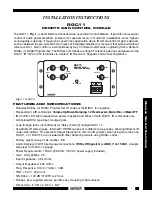
CMi413
0 User’s Manual English
CMi413
0 User’s Manual English
page | 12 (25)
[2020-06]
V1.1
signal conditions are poor, the network server will incrementally lower the data rate until it is able to
receive the message. When the data rate is low, the energy consumption per telegram will increase.
6.6 Transmit interval
The transmit interval is used to set how frequently the module should transmit data on the LoRaWAN
network. The parameter can be set to a value between 5 and 1440 (i.e. between 5-minute and daily
values.)
6.6.1 EcoMode
When EcoMode is active, a battery-lifetime of at least 11+1 years is guaranteed for the module. The
module is able to achieve this by using a table of allowed transmit intervals settings for each data rate.
When radio conditions are poor (and data rate is low), the module will be able to send data less
frequently in order to conserve battery-life. When signal conditions are good, the module will be able to
send data more frequently. When EcoMode is enabled, the module will continuously check if the set
transmit interval is “allowed” by the EcoMode table. If a longer transmit interval is needed for the specific
data rate in order to achieve 11 years of battery life, the module will adjust the parameter accordingly.
Table 3 shows the transmit intervals that the module will use for different data rates in order to achieve a
11-year battery-life.
Data rate
Transmit interval
DR0
240 min
DR1
120 min
DR2
60 min
DR3
60 min
DR4-DR5
30 min
Table 3: Transmit intervals for different data rates in EcoMode
.
If EcoMode has been disabled, guarantees about battery-life is no longer valid (even if
EcoMode is activated later).
6.7 Message formats
CMi4130 has six different message formats:
Standard
,
Compact
,
JSON
,
Scheduled
– Daily redundant,
Scheduled
– Extended
and
Combined heat/cooling
. Each message format will be described in detail in
this section.
6.7.1 Message structure
Message formats
Standard, Compact, Scheduled
– Daily redundant, Scheduled – Extended
and
Combined heat/cooling
are encoded on M-Bus format (date/time field are encoded on M-Bus format F).
Message format JSON is encoded on JSON format. All messages begin with one byte specifying the
message format used.
All M-Bus encoded messages begin with one byte specifying the message format used. Then follows a
sequence of data information blocks (DIBs), each one containing a data information field (DIF), a value
information field (VIF) and a data field (DATA). The structure of the telegram is illustrated in Figure 4.











































